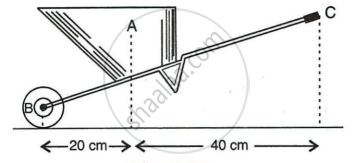Advertisements
Advertisements
प्रश्न
When does a machine act as (a) a force multiplier, (b) a speed multiplier? Can a machine act as a force multiplier and a speed multiplier simultaneously?
उत्तर
- When the effort required to overcome a specific load is less than the load, the machine has a mechanical advantage greater than one (M.A. > 1) and functions as a force multiplier. In a machine, if the displacement of load is smaller than the displacement of effort and the velocity ratio is greater than one (V.R. > 1), it functions as a force multiplier. For example, pliers and a spoon are used to open the lid of a jar.
- If a machine requires more effort than its load, it has a mechanical advantage of less than one (M.A. < 1) and acts as a speed multiplier. A machine with a velocity ratio of less than one (V.R. < 1) functions as a speed multiplier by displacing more weight than effort. For example, scissors are used to cut a piece of cloth with blades that are larger than the handles.
A machine cannot function simultaneously as both a force multiplier and a speed multiplier. For a speed multiplier, M.A. and V.R. must be less than 1, while M.A. and V.R. must be greater for a force multiplier.
APPEARS IN
संबंधित प्रश्न
Define the term efficiency of a machine.
- State the relationship between mechanical advantage, velocity ratio and efficiency.
- Name the term that will not change for a machine of a given design.
How is the mechanical advantage related with the velocity ratio for an actual machine? State whether the efficiency of such a machine is equal to 1, less than 1 or more than 1.
Draw diagrams to illustrate the position of fulcrum load and effort, in the following:
A seesaw
Draw a diagram to illustrate the position of fulcrum load and effort, in the following:
A common balance
Draw a diagram to illustrate the position of fulcrum load and effort, in the following:
A nut cracker
Draw a diagram to illustrate the position of fulcrum load and effort, in the following:
Forceps
Figure below shows a wheel barrow of mass 15 kgf carrying a load of 30 kgf with its centre of gravity at A. The points B and C are the centre of wheel and tip of the handle such that the horizontal distance AB = 20 cm and AC = 40 cm.

Find:
- the load arm,
- the effort arm,
- the mechanical advantage and
- the minimum effort required to keep the leg just off the ground.
A fire tongs has arms 20 cm long. It is used to lift a coal of weight 1.5 kgf by applying an effort at a distance 15 cm from the fulcrum. Find:
- the mechanical advantage of fire tongs and
- the effort needed.
A machine works as a
- force multiplier,
- speed multiplier.
In each case, state whether the velocity ratio is more than or less than 1.
